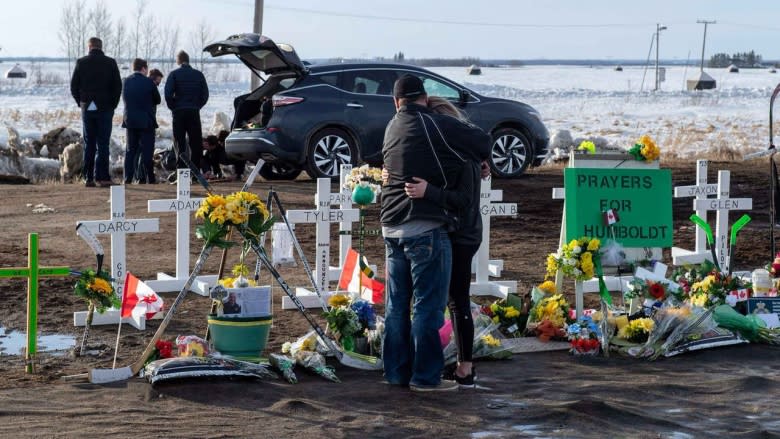Broncos crash raises questions about stop signs at 100 km/h intersections
It's a common sight on Saskatchewan highways: a vehicle on a side-road moves along the flat horizon toward an intersection you — the driver — are about to pass.
Often one of the drivers has a stop sign. Sometimes the speed limit on both intersecting roads is 100 kilometres-per-hour or more.
Both were the case at the intersection of provincial Highways 35 and 335, where the Humboldt Broncos team bus and a semi-trailer collided south of Nipawin, Sask., killing 16 people.
Now the rural municipality where the crash occurred is asking the province to review how it handles highway intersections.
No stop signs at Ont., B.C. provincial 100 km/h intersections
Some provinces, such as Ontario and British Columbia, never use stop signs at intersections on provincial highways with 100-kilometre-per-hour speed limits.
In B.C., stop signs are typically only installed on slower-speed side roads to warn the driver they must stop prior to crossing or turning onto a highway.
In Ontario, stop signs on provincial highways with speed limits of 100 km/h do not exist because commuters enter and exit freeways and other high speed, high traffic areas through interchanges, according to that province's ministry of transportation.
The law in that province does allow municipalities to assign their own speed limits up to 100 km/h approaching intersections.
But Ontario collision reconstruction analyst Jason Young, who said he has worked on thousands of cases, said he is not aware of any that do so.
"We would never have an intersection above the speed of 80 [kilometres] or potentially 90 with a stop sign," said Young, the president of Advantage Forensics Inc. in Toronto.
Reaction time a key consideration
The Broncos junior hockey team was heading to Nipawin, Sask., for a semifinal game against the Nipawin Hawks on April 6. Their bus was travelling northbound on Highway 35. It would have had the right-of-way at the intersection with Highway 335.
The semi-trailer travelling west along 335 would have approached a stop sign and a flashing red warning light before the crossing. There are also "stop ahead" signs warning the traffic travelling on Highway 335 that they are approaching the junction.
But, for reasons that remain unclear, the truck and bus collided.
Police are still investigating the crash and say it will take time to determine the cause.
Young said the speed at which each vehicle was travelling and the time that each driver had to react will be major considerations for investigators. A vehicle going 100 km/h is travelling 30 metres per second, he said.
"It's very important in collision reconstructions to know where the cars were and when they were at those positions in order to really assess properly could either driver do anything to have avoided this collision, or not," said Young.
"There are many cases where the drivers can't avoid it because there simply isn't enough time."
RM to call for provincial review
The Rural Municipality of Connaught, where the collision occurred, is planning to call for a provincial review of intersections across Saskatchewan.
"After this crash, maybe this brings light ... maybe the safety of all intersecting highways needs to be reviewed," said deputy reeve Ian Boxall.
"I guess that I would like to look at traffic flow and whether what is there currently is adequate: stop signs, speed limits, flashing lights."
Boxall said the provincial Ministry of Highways has agreed to meet with the RM after the RCMP investigation has ended.
He said lowering speed limits at the approach to some stop-sign intersections could be an option, but noted that traffic-flow is low on rural Saskatchewan roads.
Province says 100 km/h limit at stop signs is common
The Saskatchewan Ministry of Highways and Infrastructure said in an emailed response to questions that similar intersections are not uncommon.
"Stop signs at rural highway-to-highway intersections with speed limits of 100km/h are common throughout North America," it said.
"At rural highway-to-highway intersections, the Ministry of Highways and Infrastructure will generally maintain free flow for traffic on the road with the highest traffic volume and the stop sign will be assigned to the road with lower traffic volume."
It said speed limits on the road with the lower traffic volumes are usually either 90 or 100 kilometres-per-hour.
Four-lane divided highways with 110 km/h speed limits usually don't have stop signs, said the ministry.
The ministry said it is investigating the collision from a traffic engineering and operations perspective to determine what additional safety measures will be needed.
In the meantime, a temporary speed limit of 60 km/h has been implemented due to the number of people congregating at a memorial at the intersection.
Speeds to be major part of investigation: analyst
"While work on our investigation has begun, one of the most important pieces of information is the RCMP's determination of cause," said the ministry.
The RCMP has publicly stated that this will be a complex investigation and may take some time to conclude."
Last week, the RCMP shut down the intersection for a day so collision analysts could continue their investigations, including a re-enactment using similar vehicles to those involved in the crash.



